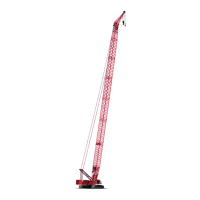HYDRAULIC SYSTEM 16000 SERVICE/MAINTENANCE MANUAL
2-2
Published 05-03-17, Control # 228-03
High Duty Circuits
High duty circuits can include, but are not limited to hoists,
boom lift, swing, travel, pump suction and discharge to
directional valves, and directional valve return-to-reservoir
circuits. Replace hoses on these circuits after 4,000 to 5,000
hours of service life.
HYDRAULIC SYSTEM MAINTENANCE
Safety
Use the following safety precautions when maintaining the
hydraulic system:
• Lower or securely block hydraulically operated
attachments and loads before service. Do not rely on
controls to support attachments or loads.
• Stop the engine and relieve hydraulic pressure to zero
before servicing or disconnecting any part of the
hydraulic system. After stopping the engine, operate
controls in both directions to relieve pressure.
• Before servicing the hydraulic system, attach a warning
sign to the engine start controls to warn other personnel
not to start the engine.
• Do not perform any hydraulic system maintenance,
adjustment or repair procedures unless authorized to do
so. Read and understand all applicable instructions.
• Do not alter specified pressure settings. Pressures
greater than specified can cause structural or hydraulic
failure. Pressures lower than specified can cause loss of
control.
• Check for leaks using a piece of cardboard or wood.
Never check for hydraulic leaks using your hands. Oil
under pressure can penetrate skin, causing serious
injury. Oil escaping from a small hole can be very difficult
to see.
Storing and Handling Oil
Use the following guidelines when storing or handling oil:
• Store oil drums in a clean, cool, dry location. Avoid
outdoor storage.
• Store oil drums on their side and cover them to prevent
water and dirt from collecting on them.
• When handling drums and transfer containers, use care
to avoid damage, which can cause leaks and allow dirt
or water into the oil.
• Before opening a drum, carefully clean the top of the
drum. Clean faucets or pumps used to remove oil from
the drum.
• Only use clean transfer containers.
• Do not take oil from storage until the oil is needed. If oil
cannot be used immediately, keep the transfer container
tightly covered.
Storing and Handling Parts
Use the following guidelines when storing or handling parts:
• Store new parts (valves, pumps, motors, hoses, tubes)
in a clean, dry indoor location.
• Do not unpack parts or remove port plugs until the parts
are needed.
• Once unpacked, carefully inspect each part for damage
that may have occurred during shipping. Remove all
shipping material from any ports on the parts before
installing.
• Clean fittings, hoses, and tubes before use that are not
equipped with shipping caps or plugs. Flush fittings,
hoses, and tubes with clean hydraulic oil. Seal all
openings until the part is installed.
• Do not use rags to plug openings. Use clean plastic
shipping plugs and caps.

